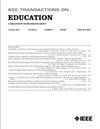利用在线模拟器和远程访问的无线电通信混合实验室
IF 2.1
2区 工程技术
Q2 EDUCATION, SCIENTIFIC DISCIPLINES
引用次数: 0
摘要
贡献:无线电通信实验课远程教学的两个工具集:1) 用于学生个人作业的在线模拟器;2) 用于小组作业的实验室工作站远程访问系统。介绍了这两种工具的初始假设和实施方法。背景:COVID-19 大流行迫使各级教育改变教学方式。实验室等实践性课堂的特殊性意味着所使用的工具必须是为特定类型的活动准备的非典型工具。预期成果:混合实验室配备在线模拟器和远程访问实验室工作站等远程学习工具,使学生能够在无线电通信领域取得与课堂教学相同的教学效果。应用设计:在线模拟器是作为 html 页面的一部分在网络浏览器中运行的 Javascript 代码,可以方便地与各种学习平台和网络服务器集成。远程访问系统的用户界面使用 Javascript 代码,网关服务器基于 Apache 网络服务器和 FastCGI 接口,可与负责控制测量设备的 C/C++ 程序通信。研究结果在两年的远程学习中,在线模拟器得到了学生的积极评价,但远程班和现场班的成绩比较并无定论。第一年的远程实验室成绩相当,但第二年的成绩比课堂学习成绩差。尚未对远程访问实验台的系统进行评估。本文章由计算机程序翻译,如有差异,请以英文原文为准。
Hybrid Laboratory of Radio Communication With Online Simulators and Remote Access
Contribution: Two toolsets for the remote teaching of radio communication laboratory classes: 1) online simulators for individual work of students and 2) a remote access system to laboratory workstations for group work. Initial assumptions and method of implementation of both tools are presented. Background: The COVID-19 pandemic has forced a change in teaching at all levels of education. The specificity of practical classes, such as laboratories, means that the tools used must often be atypical, prepared for a specific type of activity. Intended Outcomes: Hybrid laboratory with tools for remote learning in the form of online simulators and remote access to laboratory workstations, enabling students to achieve the same educational results in the field of radiocommunication as presential classes. Application Design: Online simulators were prepared as Javascript code run in a Web browser as part of a html page, which provide easy integration with various learning platforms and Web servers. The remote access system uses Javascript code for the user interface and a gateway server based on an Apache Web server and FastCGI interface to communicate with C/C++ programs responsible for controlling measuring equipment. Findings: Online simulators have been positively assessed by students during two years of remote learning, but comparison of the grades from remote and presential classes is inconclusive. The obtained grades were comparable in the first year of remote laboratories, but they were worse in the second year than the grades from classroom learning. The system for remote access to the laboratory stands has not yet been evaluated.
求助全文
通过发布文献求助,成功后即可免费获取论文全文。
去求助
来源期刊

IEEE Transactions on Education
工程技术-工程:电子与电气
CiteScore
5.80
自引率
7.70%
发文量
90
审稿时长
1 months
期刊介绍:
The IEEE Transactions on Education (ToE) publishes significant and original scholarly contributions to education in electrical and electronics engineering, computer engineering, computer science, and other fields within the scope of interest of IEEE. Contributions must address discovery, integration, and/or application of knowledge in education in these fields. Articles must support contributions and assertions with compelling evidence and provide explicit, transparent descriptions of the processes through which the evidence is collected, analyzed, and interpreted. While characteristics of compelling evidence cannot be described to address every conceivable situation, generally assessment of the work being reported must go beyond student self-report and attitudinal data.
 求助内容:
求助内容: 应助结果提醒方式:
应助结果提醒方式:


